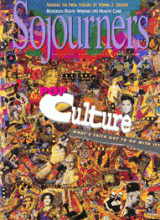Try to imagine civil rights marches without the spirituals, AIDS awareness campaigns without the quilt, Columbus Day resistance without sage and drums, South African freedom without toi-toi in the streets, Salvadoran elections without painted public murals, women's empowerment without new fashions and poetry, and '90s rebellion against '80s greed without R.E.M., Pearl Jam, and Arrested Development. Meaningful art comes most out of struggle.
I've learned history best from the artists, especially the musicians-not from the politicians. A particular peoples' dreams, pain, and accomplishments are most effectively conveyed on canvas or strings and in word, where creativity and freedom are the motivators-not power; where building up-not tearing down-is the goal.
Our simple Washington, D.C. vigils for peace in Sarajevo were most memorable because of the lone violin playing Albinoni's "Adagio for Strings," as cellist Vedran Smailovic played it for 22 days at the site of the 1992 breadline massacre in that devastated city. Whose heart could not be moved?
As a reminder of these things, I keep on my jean jacket a button with Emma Goldman's words, "If I can't dance, I don't want to be part of your revolution." Our acts of resistance, regardless of the cause, must include the art of struggle. Artists who create for the sake of their souls and ours, and not for commercial value, are (paradoxically) the ones we must support.
May all the art of struggle, and of new vision, be acceptable in the sight of God: "Praise God with trumpet sound; praise God with lute and harp! Praise God with tambourine and dance; praise God with strings and pipe!" (Psalm 150:3-4).
Karen Lattea was managing editor of Sojourners when this article appeared.
Read the Full Article

